|
Human Differentiation
Evolution of Racial Characteristics |
|
|
|
Migration and Differentiation of Modern Humans
The original Homo sapiens environment in eastern sub-Saharan Africa consisted of tropical and equatorial forests, savannahs, and riverine settings that suited their hunter-gatherer lifestyle. Over thousands of years, evolution had optimized their physical characteristics for sustained occupation of their surroundings. Their range extended from latitude 20 deg North to 35 deg South. Their heads tended to be elongated, to better support heat dissipation, and their skin, eye and hair color was likely dark, to protect against relatively high levels of UV radiation.
A global cooling trend that began about 130,000 years ago caused average temperatures to drop from about 10 deg F higher than current levels to about 15 deg F lower than current levels by 70,000 years ago. During the last glacial maximum, 26,000 to 19,000 years ago, ice sheets covered much of northern Europe, northern Asia, and North America. Elsewhere during that period there were numerous mountain glaciers.
A global warming trend that began about 18,000 years ago caused glaciers to recede and brought temperatures close to current levels by 10,500 years ago. These long-term worldwide climate changes affected humidity, vegetation, sea levels and coastlines, and the distribution and abundance of animal prey.
When environmental changes caused some Homo sapiens populations to migrate away from Africa, they encountered new environments and adapted their lifestyles to suit their new-found circumstances. Expanding populations tended to maintain contact with groups they had moved away from, through tribal or family connections or for access to known resources, for example chert, flint, and certain types of wood. Over tens of thousands of years, Homo sapiens traveled tens of thousands of miles and moved into habitats ranging from arid to rain forest, from sweltering hot to frigid, from sea-level to highly elevated, and from plain to mountainous. The vast distances covered, and the encounter of physical barriers that once surmounted were unlikely to be crossed again, sometimes resulted in the practical isolation of populations.
Some populations were isolated sufficiently long in their new habitats to develop inheritable characteristics that distinguished their members from those of different provenance. Certain evolutionary trends were adaptations to the general environment. For example, in general, body size increased with decreasing ambient temperature, and skin darkness decreased with increasing latitude. Other evolutionary trends were driven by local conditions, such as humidity and winds, and by prevalent infectious diseases.
Sustained reproductive isolation of human populations exposed to differing environments led over time to the evolution of distinct human races. The Homo sapiens species came to comprise a number of races, differentiated natural human populations. The area within which a race evolved is its ecosphere. The borders of an ecosphere are either barriers of a physical type, such as seas or mountains, or zones where there is a change in environment, such as a transition from arable land to desert.
Human differentiation has led to the evolution of seven races, groups of people of substantially common ancestry, that may be distinguished from others by biological characteristics: Australian Aborigines and Papuans, American Indians (Native Americans), Pacific Islanders, Blacks (Sub-Saharan Africans), Whites (Caucasians), Dravidians (Indians), and Asians.
Australian Aborigines and Papuans
 Australia, New Guinea and nearby islands are the ecosphere of the Australian Aborigine and Papuan race. Before the end of the last glacial period, 19,000 years ago, New Guinea, Australia and Tasmania were part of the same land mass and had similar animal and plant populations. Humans passed through New Guinea and settled there on their way to Australia. Homo sapiens reached Australia about 50,000 years ago, when the expansion of glaciers caused a lowering of sea levels and narrowed the gap between southeast Asia and the New Guinea-Australia land mass. Bands of humans expanded throughout the Australian continent and what is now Tasmania but settled mostly on the eastern regions of Australia.
Australia, New Guinea and nearby islands are the ecosphere of the Australian Aborigine and Papuan race. Before the end of the last glacial period, 19,000 years ago, New Guinea, Australia and Tasmania were part of the same land mass and had similar animal and plant populations. Humans passed through New Guinea and settled there on their way to Australia. Homo sapiens reached Australia about 50,000 years ago, when the expansion of glaciers caused a lowering of sea levels and narrowed the gap between southeast Asia and the New Guinea-Australia land mass. Bands of humans expanded throughout the Australian continent and what is now Tasmania but settled mostly on the eastern regions of Australia.
Australia and New Guinea became isolated from mainland Asia due to rising sea levels since the end of the last glacial maximum 19,000 years ago. The land bridges linking Australia to New Guinea and nearby lands began to be submerged about 13,000 years ago. By 6,000 years ago the Torres Straits reached close to the present configuration.
About 2,000 B.C., seafaring populations from East Asia reached New Guinea and some settled coastal regions that had previously been inhabited only by aboriginal Papuan peoples. Spanish and Portuguese explorers first reached New Guinea in the early sixteenth century. Dutch explorer Willem Janszoon landed in Queensland, Australia, in 1606 A.D.
Australian Aborigines are commonly of fair stature, with well-developed torso and arms, and slender legs. The color of the skin is a shade of chocolate-brown or black, and the eyes are very dark brown or black. The hair is usually raven-black, not woolly, but fine and silky in texture, wavy, and long. The beard in males is well developed, as is the hair upon the body and the eyebrows. Male pattern balding is relatively common. Most Australian Aborigines (61 per cent) have blood type O.
The Australian Aborigines are typically dolichocephalic (narrow-headed), their cranial index (per cent ratio of cranial breadth to length) rarely exceeding 75 or 76. The brow-ridges are strong and prominent. The skull shape, looked from behind (norma occipitalis) is often sharply pentagonal. The nose is broad, the jaws are heavy, and the lips thick. Looked from the side (norma lateralis) the face tends to prognatism.
 Aboriginal Papuans, descendants of the humans that first settled New Guinea, are racially similar to Australian Aborigines. Papuans typically have curly and sometimes wooly hair rather than the wavy hair typical of Australian Aborigines.
Aboriginal Papuans, descendants of the humans that first settled New Guinea, are racially similar to Australian Aborigines. Papuans typically have curly and sometimes wooly hair rather than the wavy hair typical of Australian Aborigines.
Australian Aborigine and Papuan populations diverged genetically and culturally during several thousand years of geographical separation. Unlike Australian Aborigines, who were strictly hunter-gatherers, aboriginal Papuans practiced agriculture. Their somewhat lower stature may result from lower protein intake or from adaptation to a more humid environment with greater vegetation cover than the desert-dwelling Australians.
Papuans speak many different native languages which are distinct from Asian and Polynesian languages. Papuan languages spoken in the New Guinea highlands have lexical similarities to reconstructed proto-Australian, indicating enduring similarities despite 6,000 to 8,000 years of geographical separation.
American Indians (Native Americans)
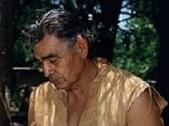 North America, South America, and the Caribbean islands are the ecosphere of the American Indian race. About 20,000 years ago, glaciers forming in the northern hemisphere locked up so much water that the ocean levels became 300 feet lower than today. A land bridge closed the Bering Strait, forming a land passage between northern Asia and America. The asiatic ancestors of American Indians first migrated from Siberia to Alaska about 14,000 or 15,000 years ago. The passage existed until about 10,500 years ago, when temperatures reached current levels and the Bering connection was severed by rising sea levels.
North America, South America, and the Caribbean islands are the ecosphere of the American Indian race. About 20,000 years ago, glaciers forming in the northern hemisphere locked up so much water that the ocean levels became 300 feet lower than today. A land bridge closed the Bering Strait, forming a land passage between northern Asia and America. The asiatic ancestors of American Indians first migrated from Siberia to Alaska about 14,000 or 15,000 years ago. The passage existed until about 10,500 years ago, when temperatures reached current levels and the Bering connection was severed by rising sea levels.
Following their initial migration to North American territories, early American Indians traveled to and settled Central America and the Caribbean islands. They began to settle in South America by 12,500 years ago. The isolation of American Indians persisted until Europeans reached America in 1492, when a Spanish expedition led by Christopher Columbus landed in the Bahamas.
 The term Indian as applied to original peoples of the Americas came about because Columbus was attempting to reach the Far East when he discovered America. At the time, European ideas of how the peoples of Asia and India looked like were vague. Columbus assumed that he had reached the Indies mentioned by Marco Polo in the accounts of his travels and he named the natives Indians. By the time Europeans figured out that America was not the Far East the name Indian was in common use and it remained the standard term. To avoid confusion with the peoples of the Indian subcontinent, the term American Indian is used.
The term Indian as applied to original peoples of the Americas came about because Columbus was attempting to reach the Far East when he discovered America. At the time, European ideas of how the peoples of Asia and India looked like were vague. Columbus assumed that he had reached the Indies mentioned by Marco Polo in the accounts of his travels and he named the natives Indians. By the time Europeans figured out that America was not the Far East the name Indian was in common use and it remained the standard term. To avoid confusion with the peoples of the Indian subcontinent, the term American Indian is used.
American Indians have reddish-brown skin. The hair is dark brown or black, lank, with circular cross section. Body and facial hair are typically sparse. Male pattern baldness is rare. The eyes are dark brown or black. The nose is typically long and narrow. The head shape is typically dolichocephalic.
Most American Indians (91 per cent) have blood type O. The front teeth (incisors) of American Indians often display a characteristic shovel shape.
Pacific Islanders
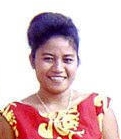 Polynesia, a group of over 1,000 islands in the central and southern Pacific Ocean, is the ecosphere of the Pacific Islander race. Geographically, Polynesia is a triangle with its three corners at Hawaii, New Zealand, and Easter Island. Polynesia includes Samoa, Tonga, the Marquesas, the Solomons, French Polynesia, and other island groups located within the Polynesian triangle. About 2,500 B.C., seafaring peoples from East Asia (principally Taiwan) traveled to Indonesia, New Guinea, and islands in the western South Pacific. Later, they migrated by large canoes to islands east of New Guinea and reached Samoa about 1,500 B.C. Continuing their seafaring ways, they reached Hawaii by 100 A.D., New Zealand by 800 A.D., and Easter Island by 1,000 A.D.
Polynesia, a group of over 1,000 islands in the central and southern Pacific Ocean, is the ecosphere of the Pacific Islander race. Geographically, Polynesia is a triangle with its three corners at Hawaii, New Zealand, and Easter Island. Polynesia includes Samoa, Tonga, the Marquesas, the Solomons, French Polynesia, and other island groups located within the Polynesian triangle. About 2,500 B.C., seafaring peoples from East Asia (principally Taiwan) traveled to Indonesia, New Guinea, and islands in the western South Pacific. Later, they migrated by large canoes to islands east of New Guinea and reached Samoa about 1,500 B.C. Continuing their seafaring ways, they reached Hawaii by 100 A.D., New Zealand by 800 A.D., and Easter Island by 1,000 A.D.
Pacific island peoples traveled within the island groups by canoes using a range of navigational techniques, including a form of celestial navigation, the movement of ocean currents, and wave patterns. They derived sustenance from fishing, land animals, and from fruits and vegetables grown in island gardens. Over time, their isolation from others and adaptation to their environment led to the evolution of distinct Pacific Islander racial characteristics.
Pacific Islanders have skin of various shades of brown. The eyes are dark brown or black, with some obliquity and incidence of epicanthal fold. The nose is usually short and the hair is black, lank, and long. Pacific Islanders are mostly dolichocephalic, but some have mesocephalic (medium) or brachycephalic (wide) skull proportions. The most common blood types in Pacific Islanders are A (50 per cent) and O (42 per cent).
Blacks (Sub-Saharan Africans)
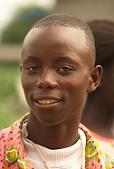 Sub-Saharan Africa is the ecosphere of the Black race. Although Africa is the original Homo sapiens environment, the present black population is the result of many thousands of years of natural selection in changing environments. There were several migrations across Africa. The early Homo sapiens migrations out of Africa, over time, were followed by population movements from Europe and Asia back and forth to Africa. But the Saharan desert presented a difficult obstacle, and the sub-Saharan population remained for the most part isolated. Having originated from the initial human population, it is also the most diverse.
Sub-Saharan Africa is the ecosphere of the Black race. Although Africa is the original Homo sapiens environment, the present black population is the result of many thousands of years of natural selection in changing environments. There were several migrations across Africa. The early Homo sapiens migrations out of Africa, over time, were followed by population movements from Europe and Asia back and forth to Africa. But the Saharan desert presented a difficult obstacle, and the sub-Saharan population remained for the most part isolated. Having originated from the initial human population, it is also the most diverse.
Blacks are, except for pygmies, typically of fair stature, and the body and limbs slender. Pygmies are a subrace in central Africa where adult males grow to less than 4 feet 11 inches in average height. In Blacks, the skin is of various shades of brown to black. The primary determinant of skin color is the amount, density and distribution of the pigment melanin, which is associated with environmental factors varying with latitude. Dark skin offers protection from harmful UV radiation. The percentage of light reflected from black or dark brown skin varies from 12 to 42 per cent, whereas it rises to 55 to 72 per cent for white or tan skin.
Blacks have dark brown or black eyes. The hair is black, short and crisp or woolly, kinky, with flat elliptical cross section. In males, the beard and body-hair are usually scanty. Blacks are typically dolichocephalic. Brow ridges are rarely prominent. The norma occipitalis is often pentagonal. In side view, the face tends to prognathism. The nose is flat as well as broad, and the lips are thick and projecting. The majority of Blacks (54 per cent) have blood type O.
Steatopygia, a high degree of fat accumulation on the buttocks, is most common in native southern African populations. This distinctive characteristic, most noted in females, appears to be an adaptation to varying cyclic nutritional opportunities for hunter-gatherers. The front teeth (incisors) of Blacks often display a characteristic flat, spatulate shape.
Whites (Caucasians)
 Europe, the Near East and North Africa are the ecosphere of the White race. By about 50,000 years ago, Homo sapiens populations began moving northward into southeastern Europe from the Middle East. The area they moved into was cold and forested. These Homo sapiens populations were followed by later migrations out of western Asia. The Cro-Magnons reached western Europe about 35,000 years ago.
Europe, the Near East and North Africa are the ecosphere of the White race. By about 50,000 years ago, Homo sapiens populations began moving northward into southeastern Europe from the Middle East. The area they moved into was cold and forested. These Homo sapiens populations were followed by later migrations out of western Asia. The Cro-Magnons reached western Europe about 35,000 years ago.
Although there were subsequent back-and-forth migrations, physical boundaries tended to isolate the populations that evolved into the White race. The Arctic to the north, the Atlantic Ocean to the west, the Sahara desert and the Arabian Sea to the south, and the Indus River, the Sind desert, and the Ural mountains to the east, presented difficult geographic obstacles.
Whites tend to be of relatively tall stature. They have white or tan skin. The tan on some can be quite dark. The eyes are black, brown, blue, green, hazel or grey. Light-colored irises seem to have evolved in response to relatively dim daylight conditions particularly prevalent in forested areas of northern Europe.
Light-colored skin is an adaptation to higher latitudes, favoring low levels of melanin pigmentation for prevalent low levels of UV radiation, to improve Vitamin D synthesis in the absence of brilliant sunlight. In Whites, the hair is black, brown, blond, or red, straight, wavy or curly, and of oval cross-section. In males, the beard is abundant. Male pattern baldness is relatively common. In Whites, the nose tends to be long and narrow. The skull presents all varieties of forms and can be dolichocephalic, mesocephalic, or brachycephalic. In side view, the face tends to orthognathism. The blood type of most Whites is A (44 per cent) or O (40 per cent). The front teeth (incisors) of Whites often display a characteristic flat, spatulate shape.
The breakdown and absorption of lactose, the major sugar in milk, requires the enzyme lactase. Although babies are normally capable of producing lactase in sufficient amounts, more than 80 per cent of non-White humans lose this ability after about age two. Lactose-intolerant adults can suffer from abdominal cramps and diarrhea when they drink more than a little milk. Lactose tolerance apparently evolved in Whites as an adaptation permitting adult consumption of milk following the domestication of cattle about 6,000 B.C.
Dravidians (Indians)
 The Indian subcontinent is the ecosphere of the Dravidian race. Around 60,000 years ago, Homo sapiens populations in the Middle East and southwestern Asia migrated to India. Some continued to southeast Asia, and some stayed. There were subsequent population movements back and forth from the west and east. The Himalayan Mountains separate the Indian subcontinent from north central Asia, so migration to and from the north was limited. The Indus River and the Sind desert present natural obstacles to the west, and the Arakan Mountains impede travel between the Indian subcontinent and southeast Asia. The relative isolation led, over time, to the emergence of distinct Dravidian racial characteristics.
The Indian subcontinent is the ecosphere of the Dravidian race. Around 60,000 years ago, Homo sapiens populations in the Middle East and southwestern Asia migrated to India. Some continued to southeast Asia, and some stayed. There were subsequent population movements back and forth from the west and east. The Himalayan Mountains separate the Indian subcontinent from north central Asia, so migration to and from the north was limited. The Indus River and the Sind desert present natural obstacles to the west, and the Arakan Mountains impede travel between the Indian subcontinent and southeast Asia. The relative isolation led, over time, to the emergence of distinct Dravidian racial characteristics.
Dark-skinned indigenous peoples of India were for the most part isolated since about 6,000 B.C. The Harappan civilization flourished in the Indus valley from about 3,100 B.C. to 1,900 B.C. About 1,500 B.C., Indo-European tribes from central Asia overran northern India. These Aryan invaders formed a ruling class that was mostly assimilated into the indigenous population by about 500 B.C., during the Vedic period. In 326 B.C., Alexander the Great led his armies across the Indus River and invaded northwestern India. The Macedonian occupation was brief. It left its imprint on the northern regions of India, but did not extend to the south.
Dravidians tend to be of relatively tall stature. Their skin ranges from brown to almost black. Eyes are dark brown or black. Dravidians generally possess a dolichocephalic head with a long, narrow face and well-developed forehead. Hair is black or dark brown, straight or wavy, long. The nose is straight, long and narrow. The most prevalent blood types among Dravidians are O (37 per cent) and B (33 per cent).
Asians
 China, Mongolia, Southeast Asia, and the American Arctic are the ecosphere of the Asian race. Homo sapiens bands moved into southern Asia from the Caucasus region beginning about 50,000 years ago. Subsequent migrations reached northeastern Asia by 30,000 years ago. The range of the Asian race is an area which lies mainly to the east of a line drawn from the Ural Mountains to Burma. The Ural Mountains and the Taklamakan Desert present natural barriers to the west, and the Himalayas to the south. The eastern boundary is the Pacific Ocean. In the southeast region, the natural obstacles are the Bay of Bengal and the South China Sea. The Arakan Mountains separate the southeast Asians from the Indian subcontinent.
China, Mongolia, Southeast Asia, and the American Arctic are the ecosphere of the Asian race. Homo sapiens bands moved into southern Asia from the Caucasus region beginning about 50,000 years ago. Subsequent migrations reached northeastern Asia by 30,000 years ago. The range of the Asian race is an area which lies mainly to the east of a line drawn from the Ural Mountains to Burma. The Ural Mountains and the Taklamakan Desert present natural barriers to the west, and the Himalayas to the south. The eastern boundary is the Pacific Ocean. In the southeast region, the natural obstacles are the Bay of Bengal and the South China Sea. The Arakan Mountains separate the southeast Asians from the Indian subcontinent.
There are four main Asian subraces: Yellow (Han Chinese), Mongols, Southeast Asian, and Eskimo. Asians tend to be short in stature, but this may be at least in part due to nutrition. The skin is yellow or yellow-brown. The yellow skin likely evolved as an adaptation to cold temperatures in northern Asia. The yellow color results from a thick layer of subcutaneous fat, visible through translucent outer layers of skin.
In Asians, the nose is flat and small. The eyes have an epicanthal fold and are black or dark brown. The epicanthal fold is a fold of skin that covers the inner corner of the eye, giving Asians a characteristic narrow, almond-shaped eye shape. This adaptation probably evolved as protection against cold and windy conditions in northern Asia. The absence of the epicanthal fold in American Indian populations suggests this characteristic evolved after the Bering connection to America was severed about 10,500 years ago.
Eskimos are Asians related to native inhabitants of eastern Siberia. They first migrated, using small boats, to polar regions of North America about 6,000 B.C. They later reached Greenland. Unlike American Indians, Eskimos (Inuit and Yupik) have the epicanthal fold.
Asians have black, straight, hair, scanty on the body and face, but long on the scalp. In cross section, Asian hair is circular. Male pattern baldness is relatively rare. The head is brachycephalic or mesocephalic, the skull usually devoid of prominent brow ridges. The most prevalent Asian blood types are O (38 per cent) and B (30 per cent). The front teeth (incisors) of Asians often display a characteristic shovel shape.
Comparison of Typical Racial Characteristics
There is a broad variation of features within each of the human races, but a comparison of typical racial characteristics indicates some salient racial differences. Skin color, and hair and eye characteristics are principal visible differential traits.
| Comparison of Physical Characteristics | ||||
| Race | Skin Color | Hair | Eyes | Blood Type (per cent) |
| Australian Aborigine and Papuan | Chocolate-brown, black | Black, wavy, curly, long | Black, dark brown | O (61), A (39) |
| American Indian | Reddish-brown | Black, dark brown, lank, long, circular section | Black, dark brown | O (91), A (9) |
| Pacific Islander | Brown | Black, lank, long | Black, brown | O (42), A (50), B (7), AB (1) |
| Black | Black | Black, wooly, short, flat elliptical section | Black, dark brown | O (54), A (28), B (16), AB (2) |
| White | White, tan | Black, brown, blond, red, straight, wavy or curly, oval section | Black, brown, blue, green, hazel, grey | O (40), A (44), B (11), AB (5) |
| Dravidian | Brown to black | Black or dark brown, straight or wavy, long | Black, dark brown | O (37), A (22), B (33), AB (7) |
| Asian | Yellow, yellow-brown | Black, lank, long, circular section | Epicanthal fold, black | O (38), A (24), B (30), AB (8) |
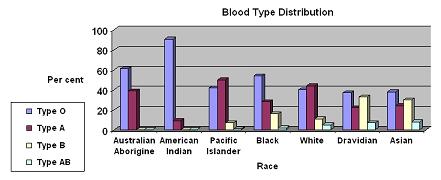 There are, as well, invisible distinguishing attibutes. For example, the particular shape in cross section of human hair can only be seen and compared with the aid of a microscope. Blood typing requires taking blood samples and using special equipment to classify the samples. The study of particular bone configurations can only be done by examining skeletons post mortem.
There are, as well, invisible distinguishing attibutes. For example, the particular shape in cross section of human hair can only be seen and compared with the aid of a microscope. Blood typing requires taking blood samples and using special equipment to classify the samples. The study of particular bone configurations can only be done by examining skeletons post mortem.
Blood types B and AB are absent from Australian Aborigines and American Indians, and only in Dravidians and Asians does blood type AB occur in more than 5 per cent of the population.
Some skeletal characteristics tend to differ among the human races. Among Blacks, the femur is often straight, whereas in Asians and Whites the femur often displays a slight anterior curvature. In Blacks, the forward tip of the mandible (the chin) is typically blunt; it is typically rounded in Asians, and pointed in Whites. Jaws are relatively larger in Blacks and Asians, and smaller in Whites. The dental arch is usually rounded in Asians, parabolic in Whites, and rectangular (hyperbolic) in Blacks.
 In the skull, the nose area, eye orbits, and brow ridges typically show significant racial differences. The eye orbits of Blacks tend to be of a more rectangular shape. Eye orbits of Whites are typically more angular, and eye orbits of Asians and American Indians more rounded. Whites typically have heavy brow ridges; Asians and Blacks have small brow ridges. Australian Aborigines and Aboriginal Papuans have heavy and prominent brow ridges.
In the skull, the nose area, eye orbits, and brow ridges typically show significant racial differences. The eye orbits of Blacks tend to be of a more rectangular shape. Eye orbits of Whites are typically more angular, and eye orbits of Asians and American Indians more rounded. Whites typically have heavy brow ridges; Asians and Blacks have small brow ridges. Australian Aborigines and Aboriginal Papuans have heavy and prominent brow ridges.
There are five distinguishing characteristics of the nose area of the skull. The root is the uppermost part of the nose, where the nasals connect to the frontal bone above. The bridge is the structure formed by the nasal bones, extending downward from the root. The spine is a bone projection at the midline bottom of the nasal opening and the front of the upper jaw bones (anterior maxillae). The nasal opening is the aperture at the front center of the skull below the eye orbits, below the bridge and above the spine and lower border. The lower border is the area at the bottom of the nasal opening, to the sides of the midline.
| Comparison of Nasal Area Bone Characteristics | |||||
| Race | Root | Bridge | Spine | Nasal Opening | Lower Border |
| Black | Low, rounded | Low | Small | Wide | Guttered |
| White | High, narrow | High | Pronounced | Narrow | Sill, sharp |
| Asian | Low, ridged | Low | Small | Medium | Flat, sharp |
Racial characteristics such as height, iris color, and skin color are polygenic traits, that is, they are influenced by several genes. Racial attributes map to sets of inheritable characteristics and are regulated by genes in different areas of the human genome. For example, hair color has been linked to genes in chromosomes 4, 15, and 16; skin color to genes in chromosomes 5, 9, 13, and 15; and blood type to genes in chromosome 9. Some invisible racial characteristics affect physical performance; others are associated with resistance or propensity to diseases and medical conditions such as hypertension, lactose intolerance, and sickle cell anemia.
The effect of racial characteristics on human performance is not so marked that it is apparent in the general population. Except due to individual handicaps, all human beings can master complicated skills such as driving an automobile. Being members of the same species, all humans share basic abilities and characteristics. But at the limit of performance, small physical differences can have a measurable effect.
The following table shows results of competitive performance at the 2008 Summer Olympics for a representative set of sports. Only individual competitions are shown, to diminish the effect of coaching and national resources on the performance comparison. Results for women are similar to the men’s results shown.
| 2008 Summer Olympics Results – Men’s Individual Competitions | |||
| Sport | Gold Medal | Silver Medal | Bronze Medal |
| Decathlon | |||
| Pentathlon | |||
| Tennis Singles | |||
| Weight Lifting 105 kg | |||
| Fencing - Sabre | |||
| Archery | |||
| Boxing 91 kg | |||
| 100 m Track | |||
| 110 m Hurdles | |||
| 200 m Track | |||
| 400 m Track | |||
| 5 km Track | |||
| Marathon | |||
| High Jump | |||
| Pole Vault | |||
| Javelin Throw | |||
| Discus Throw | |||
| Gymnastics - Artistic All-Around | |||
| Swimming 100 m Freestyle | |||
| Swimming 200 m Freestyle | |||
| Swimming 400 m Freestyle | |||
| Diving – 10 m Platform | |||
| Wrestling – FR 120 kg | |||
| Black | White | Asian |
The data suggest that, at the limit of human performance achieved by top athletes, some racial caracteristics confer competitive advantages for certain sports. For example, at the 2008 Olympic Games, Blacks dominated short-distance races and did well in the longer track trials.
Chronology and Pattern of Human Differentiation
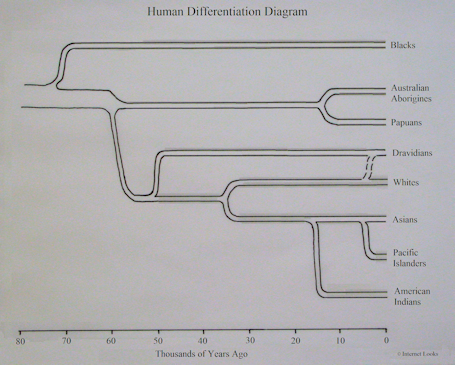 Inferences about the chronology and progress of human differentiation can be made from anthropological and historical records, and from taxonomy, genetics and linguistics, with varying degrees of certainty. The timing and nature of major human migrations can be estimated, and although many secondary back and forth movements also occurred, it is possible to identify principal population flows. As populations occupied new environments, beneficial mutations were preserved because they aided survival. Diverging changes in population traits accumulated, over time resulting in the different human races.
Inferences about the chronology and progress of human differentiation can be made from anthropological and historical records, and from taxonomy, genetics and linguistics, with varying degrees of certainty. The timing and nature of major human migrations can be estimated, and although many secondary back and forth movements also occurred, it is possible to identify principal population flows. As populations occupied new environments, beneficial mutations were preserved because they aided survival. Diverging changes in population traits accumulated, over time resulting in the different human races.
It is well established that anatomically modern humans inhabited sub-Saharan Africa 80,000 years ago. The physical record indicates that by 50,000 years ago modern humans had reached Australia, which implies that migration from the African continent must have begun substantially earlier than that. It is reasonable to assume that the earliest migrations out of Africa involved northeastern populations closest to Asia, and that those least likely to migrate inhabited southwestern areas of the continent. Over time, migrations within Africa and back and forth between Africa and other regions and subsequent relative isolation brought about adaptations resulting in the Black race.
It appears that climate limitations, in particular extreme cold temperatures, blocked human migrations to Europe and northern Asia for many thousands of years. It was not until about 30,000 or 35,000 years ago that humans moved into northern Europe and northeastern Asia. These migrations lead to a divergence between northeastern Asian populations and the inhabitants of Europe and western Asia. Relative isolation and adaptation to different environments ultimately lead to the Asian and White races.
The closing of the Bering Strait about 15,000 years ago allowed Siberian populations to cross over to the American continent. Subsequent separation from Asia lead to differentiation into the American Indian race. Later, about 4,500 years ago, peoples from East Asia began migrating by sea to the islands of the southwestern Pacific, eventually developing into the Pacific Islander race.
Modern humans reached the Indian subcontinent early in the migrations from Africa. Subsequent population movements from the west and the east gave Dravidians a mixture of east and west Asian characteristics. About 3,500 years ago, Aryan invaders moved into northern India, and in 326 B.C. Macedonian Greeks invaded northwestern India. These later influences primarily affected characteristics of northwest Indian populations.
Linguistic Comparison
In the last five centuries, the discovery of America, the circumnavigation of the Earth by European explorers, and the subsequent widespread progress in communications, trade and travel, have resulted in the breakdown of barriers separating many different peoples of the world. One effect of these changes has been the adoption of the languages of European powers by the populations of the territories they colonized, and a reduction, through disuse, of the total number of presently spoken languages. Most languages currently in use are spoken by a relatively small number of people. Only about 300 languages are spoken by more than a million.
There presently are about 6,000 different languages spoken in the world. Languages can be classified in terms of characteristics such as phonology, morphology and syntax into language families. The different languages can be grouped into about 250 language families. Representative language families and their number of speakers are listed in the following table.
| Representative Language Families | |
| Language Family | Number of Speakers |
| Indo-European | 3,000 million |
| Sino-Tibetan | 1,164 million |
| Niger-Congo | 400 million |
| Austronesian | 386 million |
| Afro-Asiatic | 350 million |
| Dravidian | 215 million |
| Turkic | 170 million |
| Austroasiatic | 65 million |
| Uralic | 25 million |
| Quechuan | 9 million |
| Mayan | 6 million |
| Mongolic | 6 million |
| Guarani | 4.6 million |
| Papuan Aboriginal | 3 million |
| Uto-Aztecan | 3 million |
| Khoisan | 350,000 |
| Na-Dene | 180,000 |
| Algic | 130,000 |
| Australian Aboriginal | 50,000 |
| Siouan | 27,000 |
| Iroquoian | 20,000 |
Humans have a distinctive capacity for verbal communication. The various human migrations and territorial isolations that preceded the availability of worldwide travel and communication contributed to the development of thousands of languages and the many language families. The following table correlates human differentiation with representative original language families.
| Linguistic Comparison | |
| Race | Representative Original Language Families |
| Blacks | Niger-Congo, Khoisan |
| Australian Aborigines | Australian Aboriginal |
| Papuan | Papuan Aboriginal |
| Dravidians | Indo-European, Dravidian, Austroasiatic |
| Whites | Indo-European, Afro-Asiatic, Turkic, Uralic |
| Asian | Sino-Tibetan, Austronesian, Austroasiatic, Mongolic |
| American Indians | Quechuan, Mayan, Guarani, Uto-Aztecan, Na-Dene, Algic, Siouan, Iroquoian |
| Pacific Islanders | Austronesian (Polynesian) |
Cognition and Situational Adaptation
There is a general human capability for learning, understanding, and dealing with novel situations. It empowers the application of knowledge to manipulate the environment and involves thinking abstractly to solve problems. Cognition includes thought processes for learning, understanding, and remembering. Adaptation can involve behavioral changes in order to cope effectively with the environment, or changing the environment.
Frenchman Alfred Binet and his colleague, Theodore Simon, developed questions that focused on areas such as comprehension, problem-solving, and memory abilities. In 1903-1905 they tested French children to determine which questions best served as predictors of success in school. Using selected questions, Binet tested a large sample of children and determined that the ability of children to answer questions of increasing difficulty correlated to their age, and that some children were able to answer less or more difficult questions than others of the same age group. Binet developed the concept of mental age, a measure of intelligence based on the average ability of children of a specific age group. These abilities are influenced by polygenic traits and by social and cultural factors. Binet and Simon went on to develop a psychometric test now referred as the Binet-Simon Scale, the basis for the Stanford-Binet intelligence test first developed in the United States in 1916 and for other current intelligence tests. In these tests, an intelligence quotient (IQ) score is calculated by dividing the mental age of a child by his chronological age, and multiplying by 100.
The capability measured by IQ tests, general intelligence, is a function of brain development that typically completes at about age 18. For individuals older than 18 years old, a fixed value of 18 is used for their chronological age. Tests, including those developed for adults, were normalized so that the average score was fixed as 100. Picture-based intelligence tests were also developed, for individuals unable to read.
The following table presents a summary of available average intelligence test data for different populations. Tests were administered in different countries in prevalent local languages. The data represent various published average test results for each population group, with varying number of tests for each group. The table shows the range of available average test scores for each population, not the range of test scores for the population. For each test average, the distribution of scores follows a bell curve, with 68 percent of test scores within plus or minus 15 points of the average, and 96 percent of scores within 30 percent of the average.
| Summary of Intelligence Test Data | ||||||
| Average Intelligence Quotient | ||||||
| Race | 50-59 | 60-69 | 70-79 | 80-89 | 90-99 | 100-109 |
| Australian Aborigine and Papuan | 52-59 | 60-69 | 70-74 | |||
| American Indian | 79 | 82-87 | ||||
| Pacific Islander | 80-85 | |||||
| Black | 54-58 | 60-67 | 70-79 | 85 | ||
| White | 78 | 80-89 | 91-99 | 100-102 | ||
| Dravidian | 77 | 81-82 | ||||
| Asian | 77 | 84-89 | 93-94 | 104-108 | ||
Mixed Race Populations
Mixed race populations occur when individuals from different races occupy the same ecosphere and intermarry. A significant portion of the current world population is of mixed race. In Mexico, and in some countries in Central America and South America, a majority of the current population is of mixed race, or mestizo, of part White and part American Indian origin. In Asia, a minority of the population is Eurasian, of part White and part Asian origin. Northwestern areas of the Indian subcontinent have peoples of part White and part Dravidian origin. In Europe, Africa, the United States, Brazil, and some countries in the Caribbean, there are significant mixed race populations of part White and part Black origin.
Negritos
In the sixteenth century, Spanish and Portuguese merchant-explorers first encountered characteristically short, dark skinned peoples in southeast Asia which they called Negritos (little blacks). Negritos are tribal peoples inhabiting certain small islands and coastal areas, from India to the Philippines. They have black to dark brown skin, broad short noses, wooly black hair, and dark irises. Adult males are less than 5 feet tall and females are shorter still. They are descended in part from Africans that settled on coastal regions of southeast Asia 70,000 to 50,000 years ago, at a time when sea levels were hundreds of feet lower than today.
Global climate changes between 19,000 and 13,000 years ago, associated with the current interglacial, resulted in sea level rises to about current levels. Early southeast Asian seaside populations mostly retreated overland to higher grounds in the interior of India, Burma, Thailand, Malaysia, the Philippines, and nearby regions. But some groups were isolated in small islands without ready access to the mainland. Over time, evolutionary pressures in their constrained environments led to a marked reduction in body size through a natural selection process called island dwarfism.
Significant isolation continues to the present day in places like the Nicobar and Andaman islands, but in most areas there has been some interbreeding between Negritos and neighboring peoples. Currently, Negritos retain their dark skin and short stature but display admixtures of other traits inherited from Dravidians and Asians.
Composition of World Populations
The geographic expansion of humans has been accompanied by a dramatic growth in total numbers. From a total population of about 5 million in 10,000 B.C., the population grew to 30 million by 3,000 B.C., when First Dynasty King Djer ruled Egypt, to 233 million by 27 B.C., when Octavian took on the name Augustus and became the first Roman Emperor, and to 477 million by 1492 A.D., when Christopher Columbus discovered America. Worldwide colonization, the industrial revolution, and mechanized agriculture led to further increases in population. The total world human population in 2022 was about 8,000 million (8 billion). The largest population concentrations are in eastern Asia, the Indian subcontinent and Europe. The composition and geographic origin of world populations is as shown in the following table.
| Composition of World Populations | ||
| Race | Per Cent1 | Geographic Origin |
| Australian Aborigine and Papuan | 0.07 | Australia and New Guinea |
| American Indians | 2 | America |
| Pacific Islanders | 0.5 | Pacific Islands |
| Blacks | 10.5 | Sub-Saharan Africa |
| Whites | 19 | Europe, Near East, North Africa |
| Dravidians | 12 | India |
| Asians | 48 | Asia |
| Mixed Race | 8 | Various |
| 1Approximate |
|